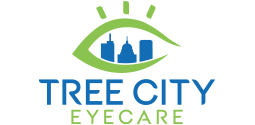If you’ve ever found yourself squinting to read a road sign or struggling with blurry vision both up close and far away, you’re not alone. Two of the most common refractive errors, myopia and astigmatism, can impact your ability to see clearly and often cause overlapping symptoms.
Understanding how these conditions differ can help you make more informed decisions about your eye health and the treatment options available to you.
Understanding Myopia
Myopia, more commonly referred to as nearsightedness, is a condition that affects your distance vision. People with myopia can usually see objects that are close to them with clarity, while distant objects appear blurry. For example, you might be able to read a book with no problem, but at the same time, you might struggle to see the television clearly from across the room.
This condition is typically caused by the eye growing too long from front to back. When the eye is elongated in this way, it focuses light in front of the retina (the part of the eye that sends signals to the brain) rather than directly on it, resulting in blurred distance vision.
While genetics play a strong role in the development of myopia, environmental factors, especially in childhood, can also contribute. For instance, a lack of outdoor activity and extended periods of close-up tasks like reading or screen time have been associated with a higher risk of developing myopia.
Myopia often develops during school-age years and tends to progress throughout adolescence. As the eyes continue to grow and change, so does a person’s degree of nearsightedness. In most cases, myopia stabilizes in early adulthood when eye growth slows and eventually stops, usually by the early 20s.
Common signs of myopia include blurry vision when looking at faraway objects, squinting to see more clearly, frequent headaches, and eye strain after prolonged periods of visual effort. Some people also rub their eyes often, especially children who may not realize they’re struggling to see properly.

What Is Astigmatism?
Astigmatism is another common refractive error, but unlike myopia, it affects your vision at all distances. People with astigmatism often experience blurred or distorted vision, whether they’re looking at something up close or far away.
Astigmatism occurs when the cornea or the lens inside the eye has an irregular shape. Instead of being perfectly round like a basketball, the surface of the eye may be shaped more like a football. This irregular curvature prevents light from focusing evenly on the retina, leading to vision that may appear stretched, wavy, or fuzzy.
Unlike myopia, which often appears in childhood and progresses as a child grows up, astigmatism is usually present from birth and may stay relatively stable throughout life. However, it can also develop later in life due to injury, surgery, or other conditions affecting the eyes. Many people with astigmatism also have other refractive errors like myopia or hyperopia (farsightedness), which can further complicate their vision and require more specialized correction.
Symptoms of astigmatism often overlap with those of other vision problems and include blurry or distorted vision at all ranges, difficulty seeing clearly at night, squinting to see better, and frequent eye strain or headaches. Because the symptoms can be subtle, many people don’t realize they have astigmatism until they have a comprehensive eye exam.
Key Differences Between Myopia & Astigmatism
Although both myopia and astigmatism affect how light focuses on the retina, and both can cause similar symptoms like blurry vision and headaches, they differ in the way they impact your vision and how they’re caused.
Myopia primarily affects distance vision. People with myopia can usually see close-up objects clearly, but find distant objects to be blurry. Astigmatism, on the other hand, affects vision at all distances. It leads to general visual distortion rather than just a loss of sharpness at a specific range.
In terms of underlying causes, myopia usually results from the eye being too long, causing light to fall in front of the retina. In contrast, astigmatism is caused by irregularities in the curvature of the cornea or lens, which leads to uneven light refraction and a failure to produce a single, sharp focus point on the retina.
How Tree City Eye Care Treats Myopia & Astigmatism
At Tree City Eye Care, we’re committed to helping you understand your eye health and finding the solutions that fit your lifestyle. We use diagnostic tools (including axial length measurement) to detect and monitor myopia and astigmatism with precision. Whether you’re managing your child’s developing vision or addressing your own long-standing concerns, we tailor our approach to your specific needs.
When it comes to treating myopia, especially in children, the goal is often to slow its progression. We offer several evidence-based options, including myopia control contact lenses like MiSight and NaturalVue lenses.
Orthokeratology (ortho-k) lenses, which gently reshape the cornea overnight, are another effective option. We may also recommend low-dose atropine eye drops, which have been shown to reduce the rate of myopia progression. For adults, treatment typically focuses on vision correction through eyeglasses, contact lenses, or refractive surgeries like LASIK.
Astigmatism is typically corrected with prescription eyeglasses or specially designed toric contact lenses. In some cases, laser eye surgery may also be an option for adults looking for a long-term solution. Because astigmatism often occurs alongside other refractive errors, it’s essential to have a personalized treatment plan based on a comprehensive eye exam.
Take the First Step Toward Clearer Vision
No matter which condition you’re dealing with, Tree City Eye Care is here to help. With a personalized approach to every patient, we can offer more than just a prescription; we can offer peace of mind. If you or your child are experiencing vision challenges, we invite you to schedule a comprehensive eye exam.


